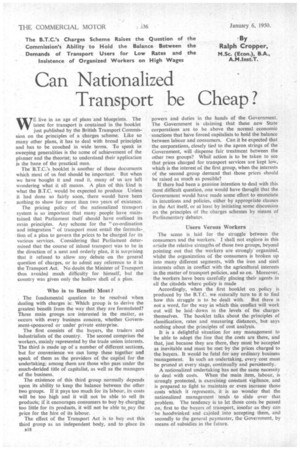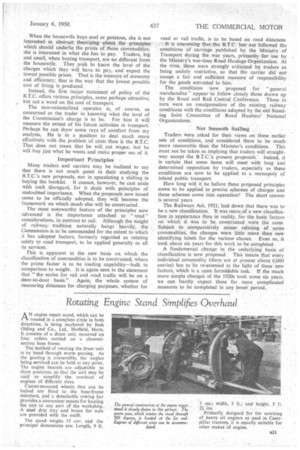Can Nationalized Transport be Cheap?
Page 52

Page 55

If you've noticed an error in this article please click here to report it so we can fix it.
WE live in an age of plans and blueprints. The Latest for transport is contained in the booklet just published by the British Transport Commission on the principles of a charges scheme. Like so many other plans, it has to deal with broad principles and has to be couched in wide terms. To speak in sweeping generalities is the acme of achievement of the planner and the theorist; to understand their application is the bane of the practical man.
The B.T.C.'s booklet is another of those documents which most of us feel should be important. But when we have bought it and read it, many of us are left wondering what it all means. A plan of this kind is what the B.T.C. would be expected to produce Unless it had done so fairly soon, there would have been nothing to show for more than two years of existence.
The pricing policy of the nationalized transport system is so important that many people have maintained that Parliament itself should have outlined its main principles. Any scheme for the "co-ordination and integration" of transport must entail the formulation of a plan to govern the prices to be charged for its various services. Considering that Parliament determined that the course of inland transport was to be in the direction of a neat and orderly plan, it is surprising that it refused to allow any debate on the general question of charges, or to admit any reference to it in the Transport Act. No doubt the Minister of Transport thus avoided much difficulty for himself, but the country was given only the hollow shell of a plan.
Who is to Benefit Most ?
.The fundamental question to be resolved when dealing with charges is: Which group is to derive the greatest benefit from the way that they are formulated? Three main groups are interested in the matter, as occurs with every business concern, whether Government-sponsored or under private enterprise.
The first consists of the buyers, the traders and industrialists of the country. The second comprises the workers, mainly represented by the trade union interests. The third is made up of a number of different sections, but for convenience we can lump these together and speak of them as the providers of the capital for the undertaking; among them are those who pass under the much-derided title of capitalist, as well as the managers of the business.
The existence of this third group normally depends upon its ability to keep the balance between the other two groups. If it pays too much for its labour, its costs will be too high and it will not be able to sell its products; if it encourages consumers to buy by charging too little for its products, it will not be able to, pay the price for the hire of its labour.
The effect of the Transport Act is to buy out this third group as an independent body, and to place its e18 powers and duties in the hands of the Government. The Government is claiming that these new State corporations are to be above the normal economic sanctions that have forced capitalists to hold the balance between labour and consumers. Can it be expected that the corporations, closely tied to the apron strings of the . Government, will dispense fair treatment between the other two groups? What action is to be taken to see that prices charged for transport services are kept low, which is the interest of the first group, when the interests of the second .group demand that those prices should be raised as much as possible?
If there had been a genuine intention to deal with this most difficult question, one would have thought that the Government would have made some effort to enunciate its intentions and policies, either by appropriate clauses in the Act itself, or at least by initiating some discussion on the principles of the charges schemes by means of Parliamentary debates.
• Users Versus Workers
The scene is laid for the struggle between the consumers and the workers. I shall not explore in this article the relative strengths of those two groups, beyond pointing out that the workers are strongly organized, whilst the organization of the consumers is broken up into many different segments, with the iron and steel interests often in conflict with the agricultural interests in the matter of transport policies, and so on. Moreover, the workers have been carefully placing their agents in all the citadels where policy is made Accordingly, when the first booklet on policy is produced by the B.T.C. we naturally turn to it to find how this struggle is to be dealt with. But there is not a word, for the way in which this conflict will work out will be laiddown in the levels of the charges themselves. The booklet talks about the principles of classification, rates and measuring distances, but says nothing about the principles of cost analysis.
It is a delightful situation for any management to be able to adopt the line that the costs are there, and that, just because they are there, they must be accepted as inevitable and must be met by the prices charged to the buyers. It would be fatal for any ordinary business management. In such an undertaking, every cost must be pruned at every stage, continually and persistently.
A nationalized undertaking has not the same necessity to deal with costs. When the main item, labour, is strongly protected, is exercising constant vigilance, and is prepared to fight to maintain or even increase those costs which it represents, it is no wonder that the nationalized management tends to slide over that problem. The tendency is to let those costs be passed on, first to the buyers of transport, insofar as they can • be hoodwinked and cajoled into accepting them, and secondly to the general paymaster, the Government, by means of subsidies in the future.
When the housewife buys coal or potatoes, she is not interested in abstract theorizing about the principles which should underlie the prices of those commodities; she is interested in what she has to pay. Traders, big and small, when buying transport, are no different from the housewife. They z.vish to know the level of the charges which they will have to pay, and expect the lowest possible prices. That is the measure of economy and efficiency; that is the way that the lowest possible cost of living is produced.
Instead, the first major statement of policy of the B.T.C. offers various principles, some perhaps attractive, but not a word on the cost of transport.
The non-nationalized operator is, of course, as concerned as the trader in knowing what the level of the Commission's charge is to be. For him it will measure the extent of his future activities in transport. Perhaps he can draw some rays of comfort from my analysis, He is in a position to deal much more effectively with the problem of costs than is the B.T.C. That does not mean that he will cut wages; but he will buy just what he wants and make proper use of it.
Important Principles
Many traders and carriers may be inclined to say that there is not much point in their studying the B.T.C.'s new proposals, nor in speculating a shilling in buying the booklet. It cannot, however, be cast aside with such disregard, for it deals with principles of undoubted importance. When the proposals now issued come to be officially adopted, they will become the framework on which much else will be constructed.
Thefl most noteworthy feature of the principles now advanced is the importance attached to " road" considerations, in contrast to rail. Although the weight of railwaytradition naturally hangs heavily, the Commission is to be commended for the extent to which it has adopted factors, formerly regarded as relating solely to road transport, to be applied generally to all its services.
This is apparent in the new basis on which the classification of commodities is to be constructed, where the prime factor is to be loading capability—bulk in comparison to weight. It is again seen in the statement that "the scales for rail and road traffic will be on a door-to-door basis." Again, the whole system of measuring distances for charging purposes, whether for
road or rail traffic, is to be based on road distances.
It is interesting that the B.T.C.has not followed the conditions of carriage published by the Ministry of Transport during the war, years, primarily for use by the Ministry's war-time Road Haulage Organization. At the time, these were strongly criticized by traders as being unduly restrictive, so that the carrier did not accept a fair and sufficient measure of responsibility for the goods entrusted to him.
The conditions now proposed for "general merchandise" appear to follow closely those drawn up by the Road and Rail Central Conference. These in turn were an amalgamation of the existing railway conditions with the conditions adopted by the old Standing Joint Committee of Road Hauliers' National Organizations.
Not Smooth Sailing Traders were asked for their views on these earlier sets of conditions, and considered them to be much more reasonable than the Minister's conditions. This must not be taken as implying that traders will straightway accept the B.T.C.'s present proposals. Indeed, it is certain that some items will meet with long and determined opposition by traders, especially as these conditions are now to be applied to a monopoly of inland public transport.
How long will it be before these proposed principles come to be applied to precise schemes of charges and those schemes come into operation? The short answer is several years.
The Railways Act, 1921, laid down that there was to be a new classification., It was nnore,of a new classification in appearance than in reality, for the basic factors on vvhich it was to be constructed were the same. Subject to comparatively minor .relisting of some commodities, the changes were little more than new identifying labels for the various classes. Even so, it took about six years for this work to be completed.
A fundamental change in the underlying basis of classification is now piloposed. This means that every individual commodity (there are at present about 6,000 entries) has to be re-assessed in the light of these new factors; which is a most formidable task. If the much more simple changes of the 1920s took some six years, we can hardly expect these far, more complicated measures to be completed in any lesser period.




























































































